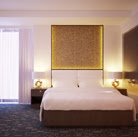
Jeffrey Lau for The New York Times
Rows of Cao Dai believers bowed in prayer.
Removing his sandals and smoothing down his robes, Vo Huu Nghia, 60, who had befriended me that day last year, joined them. He silently entered the cavernous temple and, finding a spot, knelt down and began to chant his prayers. Above him were the serene faces of Jesus, Confucius and Buddha, while a giant all-seeing eye stared down at the few hundred worshipers.
“We are Vietnamese, this is our religion,” Mr. Vo told me later in halting English.
For 70 years this elaborate, dragon-adorned temple outside the small city of Tay Ninh, about 60 miles northwest of Ho Chi Minh City (formerly Saigon) near the Cambodian border, has been the center of Cao Dai, which has five million adherents. While it is not the country’s dominant religion, it has the distinction of being its largest homegrown one.
Every year tens of thousands of visitors, pilgrims and tourists, visit the temple to worship or simply to gaze in awe at its vaulted ceilings, vibrant color schemes and praying masses. And then there’s its unusual collection of saints, prophets and religious iconography, which in range, kitsch and spectacle presents an impressive cross-section of religious and aesthetic styles. But that’s befitting a religion that aims to unite all of humanity through the common vision of an individual creator — the same God honored by most major religions. The protagonist of Graham Greene’s “Quiet American” (1955) described the temple like this: “Christ and Buddha looking down from the roof of a cathedral on a Walt Disney Fantasia of the East, dragons and snakes in Technicolor.”
I had been drawn to the temple after coming across a list of Cao Dai (pronounced gao-DIE) saints that included Joan of Arc, Thomas Jefferson, Sun Yat-sen (the revolutionary father of Chinese republicanism) and Victor Hugo. This diverse group was apparently drawn from those spirits who reached out to Cao Dai priests during séances to impart wisdom and guidance. Some, like Victor Hugo, were said to have regularly communicated with the Cao Dai from beyond the grave.
Visitors to the compound today won’t see a séance — the government banned the practice in 1970s — but there is more than enough to thrill and confuse even the most temple-weary tourist.
The compound has two ornate temples, and a pope’s office, in front of which believers subjugate themselves out of reverence for the first, and only, Cao Dai pope, Pham Cong Tac. (He died in 1959 in exile in Cambodia after running afoul of the South Vietnamese government.) The 188-acre grounds include dormitories and kitchens for the hundreds of resident priests, a high school, a hospital, forests and a large area for religious processions.
I decided to forgo the $6 daily tour buses from Ho Chi Minh City for a three-hour trip by crowded public transport to the nearby town, a journey that still afforded a view of the city’s vast sprawl giving way to miles upon miles of paddy fields. Tay Ninh is in a tropical, agricultural area, and besides the Cao Dai temple and the nearby Cu Chi tunnel system left over from the Vietnam War, there is little to draw tourists.
Checking into the nearest hotel in the small, ramshackle town that has grown around the outskirts of the temple complex, I quickly headed out for what would be the first of many Cao Dai services, which are held every six hours throughout the day and night.
Inside the main temple, worshipers and priests were already bowed, their heads planted firmly on the cool stone floor as they chanted words of praise, accompanied by a single drumbeat and a few stringed instruments.
Closest to the Divine Eye above the altar, several priests in bright red, yellow and blue robes adorned with a large eye and with elaborate headdresses led the worship. On the balconies above, foreign and Vietnamese tourists watched in silence, a concession made by the temple priests, who allow tour groups in exchange for much-needed dollars. (Every day, about a half-dozen busloads of visitors come to see the noon service before heading to the Cu Chi tunnels and then back to the city.)
Thirty minutes after the chanting had begun, it was over, and with that the worshipers stood up and quietly filed out. The priests and student priests remained, enjoying the cool temple air rather than braving the outdoor heat; some went to their rooms to rest.
Soon the tourists were gone too, and the only people left beside me were a handful of sun-worn priests occupying the temple, constructed to be the center of a holy land for a religion created from the vision of a civil servant in 1919.
Today’s striking multicolor, dragon-adorned temple was built from 1933 to 1955, and in architectural terms, is part church, part pagoda, crammed with ornate drums and gongs, haloed statues of saints and other holy figures, and lavish and colorful symbols of other religions. There’s also a sphere depicting the all-seeing Divine Eye — Cao Dai’s offering to the religious cornucopia.
Beyond the four daily services there is little for visitors to the temple complex to do but wander the well-kept grounds, talk to — or simply smile at — the priests and practitioners, and seek shelter from the scorching heat in one of the airy temple buildings. Despite this, I found that the hours drifted by in peaceful contemplation.
I also struck up conversations with a few of the faithful, aided by a translator. Most of the worshipers and temple leaders were long past retirement age, perhaps a sign of the decline of the religion or simply a natural byproduct of people raising families and working. It also seemed to be an egalitarian faith, with just as many of the priests and student priests older women.
“I was born into the faith but had a family life and raised six children,” said Ho Huong Pham, 82, a student priest. “When my husband died 20 years ago, my children were grown up and I came here to devote myself to the faith.”
On the final morning of my two-day stay in Tay Ninh — during which I had left the complex only to eat nearby street food or sleep — I was invited to drink tea with one of the temple’s bishops. A quiet, elderly man, he smiled and explained to me the importance of the various robes (yellow represents Buddhism, blue Taoism and red Confucianism). After a while we sat in silence until it was time for him to put on his yellow ceremonial robes to lead the midday service. As I got up to leave he shook my hand and invited me to come back, before slowly making his way toward the temple a hundred yards away.
On the cramped, un-air-conditioned bus that took me out of town, I remembered a conversation with a man at the temple worshiping with his granddaughter. “Cao Dai is a collection of the best parts of many religions,” the man, Huynh Van Hgoat, 53, had told me.
Despite this, he was doubtful about the future of the religion.
“Ninety percent of believers live in the Mekong,” he said. “Of course I hope the religion is growing, but I doubt it. One day there might be only tourists here.”
In 1919, Ngo Van Chieu, a lowly Vietnamese civil servant working for the French colonial administration, received a vision of God and, following the heavenly message, began preaching a credo based on the unity of world religions. According to his new doctrine this would be the third alliance between god and mankind, the first coming at the time of the founding of Judaism and Hinduism, and the second around the time that Christianity, Buddhism, Confucianism and Taoism began. Cao Dai would be the third and final alliance, the religion that would unite and prove the unified message of all of these earlier religions.
The new religion followed the Buddhist cycle of reincarnation, drew upon the ethical precepts of Confucianism, had an ecclesiastical hierarchy similar to that of the Roman Catholic church and yet preached the Taoist concept of yin-yang, of two balancing forces, good and bad.
Cao Dai spread quickly through Vietnam, and by the 1950s it was such a force that it was said to command an army of 25,000 in the Mekong region during the turbulent and uncertain days at the end of the French occupation and claim an eighth of the country’s population as believers.
This rapid growth wouldn’t last. After the Vietnam War — during which Cao Dai priests refused to side with the Vietcong, even after their military had been subdued by the South and their pope exiled — the religion had all of its land confiscated. The land around the temple was returned in 1985.
Source: The New York Times



















